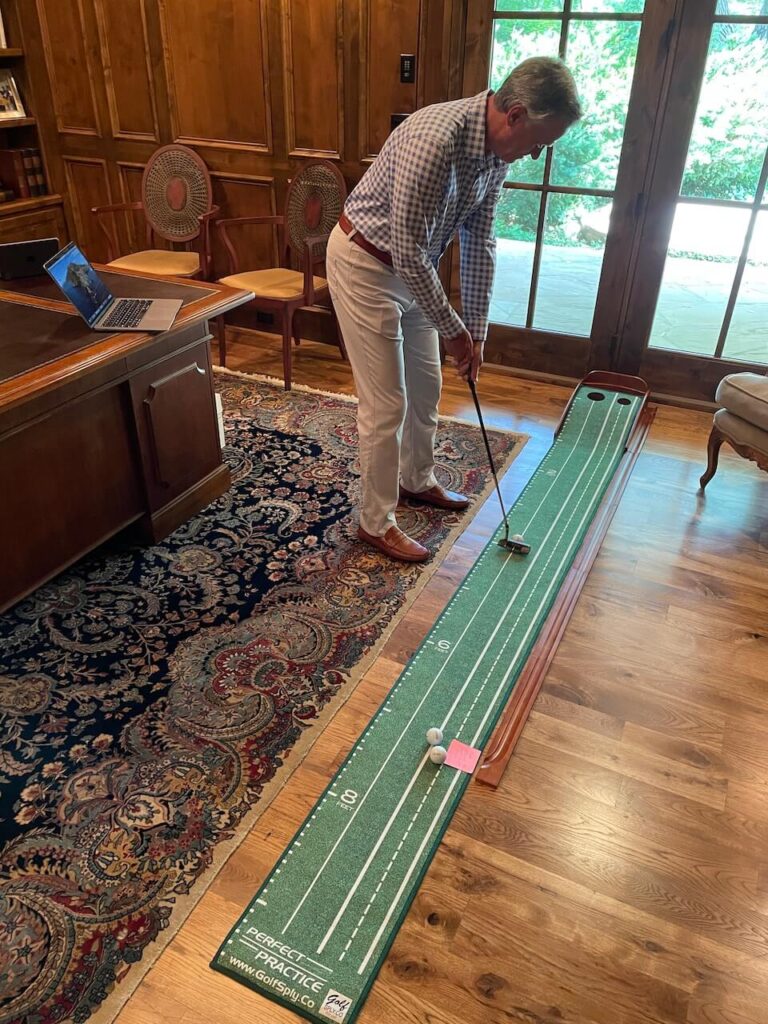The Hillsdilly is a member-guest golf tournament that’s held annually at my home course, Cherry Hills Country Club in Denver. The event dates back to at least the 1950s and has attracted the likes of Ben Hogan, Bob Hope, Dizzy Dean, and President Eisenhower as celebrity guests.
It’s a fun tournament, but it’s on a tough course that also regularly hosts USGA and PGA championship events. It’s known for its high rough, undulating fairways, and fast greens, all of which can lead to high scores, even by the best-of-the-best golfers. In fact, one pro carded a 19 on No. 16 in the 1938 U.S. Open (still the highest single-hole score in a major championship).
I bring up No. 16, because I stood on that same green several years ago facing a pressure-packed putt while partnering with my brother-in-law in the Hillsdilly.
I took my time examining the putt from every angle, because by making it we would advance to the semi-final hole. The ball rested just two feet from the hole, and while there was a tricky break in the green, it certainly was a shot I could and should make. So, with more than a hundred folks looking on, I took my final practice swings and then confidently rolled the ball toward the cup.
And I missed it.
Fortunately, we still ended up in a tie with two other groups on that hole. The good news was that we won a closest-to-the-pin chipping contest to advance to the next hole, which we also won. Then we lost on the final hole to finish in second place.

Missing that putt still bugs me, partly because I spend a good bit of time practicing my putting. But like many golfers, I don’t always spend enough time making putts when I’m actually playing the game. And that realization offers an interesting lesson for leaders.
If you play much golf, you probably are familiar with the concept of a “gimme.” Even in friendly but competitive matches, playing partners often will “give” you a putt when it’s close. Once you putt to within about 10 inches of the cup – roughly the length of the handle on a putter – you pick up the ball, add a stroke to your score, and go to the next hole.
It’s a common practice because it saves time, which is especially helpful (and often encouraged) when the course is crowded.
If you watch groups play non-tournament rounds, you’ll notice that very few players actually make putts on the course, especially close putts. And some players are very liberal when defining what is “close.” The length of a putter handle expands to two feet or three feet or more. As a result, those putts become more difficult when players get into tournaments because they aren’t in the habit of taking them, much less making them.
Never miss a post about leadership, transparency, and trust by signing up for my weekly mailing list, delivered right to your inbox. Sign up here.
The same can be true in leadership. In casual situations, we can figuratively take a gimme. Then when it really matters, we lack the practice and experience we need to make the clutch putt.
I’m not suggesting golfers should never take a gimme. If for no other reason than to speed up the pace of play, I give them and take them. But there’s a price to pay, especially if I start taking them when they aren’t really “gimmes.”
Putting is hard, especially under pressure. As Hall of Fame golfer Chi-Chi Rodriguez said, “I’ve heard people say putting is 50 percent technique and 50 percent mental. I really believe it is 50 percent technique and 90 percent positive thinking, see, but that adds up to 140 percent, which is why nobody is 100 percent sure how to putt.”
I work on short putts a lot on the practice greens, because I play in tournaments each year and practice gives me comfort in times of pressure. So I’ll take gimmes in a casual round of golf even though I know it would improve my game (if not my score) to always putt them out.
But I also see the risk in taking gimmes in more serious matters like creating excellence, treating people with respect, and displaying integrity. In such cases, close isn’t good enough. We can’t take shortcuts when there’s not much pressure and expect excellence during crunch time. No matter the situation or the offers from others, we always need to putt those out.

David Avrin
Great analogy Walt. We can never assume that we will win, execute, prevail or connect. Following through is essential. It’s like walking away from the campsite without verifying that the fire is indeed out…every…single…time.
Steven Kirk Meyer
Robert Watson always gave his putts good within the flag stick.
Rick Shafer
Great story Walt! I think I lived that story with you and I still want to hit my drive over. lol. Love the message and so true around day to day respect and integrity. I have played in enough tournaments and dealt with employees long enough to know there are no shortcuts and we develop our trust and relationships over time. Great lessons! See you soon.